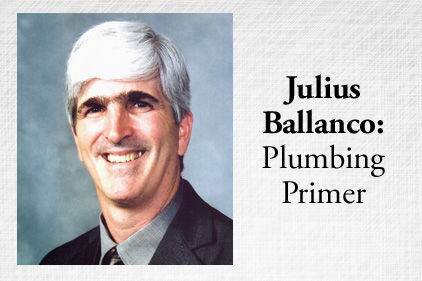Have a Merry, No-Lead Christmas
Make sure to cull your leaded inventory before Jan. 4, 2014.


|
By now, you are probably tired of hearing about the new no-lead legislation. The days are counting down until Jan. 4, 2014, the effective date of the law.
I have received a number of questions from contractors regarding certain fine points of the legislation. To add further clarity, the U.S. Environmental Protection Agency issued an FAQ document; many questions are directed toward plumbing contractors, as well as manufacturers. (You can find the FAQ document here.) The EPA is playing hard ball but you should be familiar with that.
One frequent question is what constitutes potable water applications. The law defines the potable water requirements as applying to drinking, food preparation, maintaining oral hygiene and dishwashing, which is new to this list. Previously, potable water was considered water used for drinking or cooking (food preparation). The impact will be to dishwashers and the associated water piping, but these appliances already comply with the law.
As previously identified, water closets, urinals, ballcocks, fill valves, flushometer valves, tub fillers and shower valves do not have to meet the no-lead requirements. However, that doesn’t mean the piping to these components is exempt. The EPA has stated that all pipe and fittings in potable water systems must be lead-free — without exception.
A plumbing contractor asked me if he could use up his leaded brass nipples when he installed a tub filler. At first, you would think, sure! However, with the law’s emphasis on all pipe and fittings, the nipple would qualify as a pipe and the plumbing contractor couldn’t use the leaded brass nipple in that application.
This interpretation also could be extended to chrome-plated nipples that are used for nonpotable applications. If they are installed in a potable water system, they must be no-lead chrome-plated nipples.
This raises an interesting point for chrome-plated nipples that are supplied as a part of a flushometer valve. These nipples would be a part of the fixture fitting, hence, they do not have to meet the no-lead requirements. So, if the chrome-plated leaded nipples are supplied by the flushometer manufacturer, they are acceptable because they are technically a part of the flushometer valve and not to be used for any other application.
The same restriction would be true for drop ear elbows. Most of us thought that leaded drop ear elbows could be used for connecting shower heads or tub fillers. However, this also is prohibited.
The EPA’s concern is that a contractor may confuse the fittings and use a leaded one on a drinking water supply line. There is a lot of validity to this concern.
Installed date is key
The other common question is, “What is meant by entering into commerce?”
The EPA went into great detail regarding “entering into commerce.” If you install a leaded faucet on Jan. 3 for a project that will not be completed until March 1, that is acceptable. It is not when you finish the project or even get paid for the project. It is when you actually install a product.
Many contractors thought to give away their remaining leaded faucets to customers and just charge for labor. That is illegal. The EPA explains that giving a leaded product away means you are entering it into commerce. If you do that after Jan. 4, you are violating federal law.
So if you plan on giving away your remaining leaded inventory, do so as Christmas or New Year’s presents. Just deplete everything before Jan. 4. If not, throw them in the scrap bin because that is all you can use them for after the deadline.
As for replacement parts, that’s a whole new ballgame. Many replacement stems use a leaded brass. However, that may or may not be acceptable. For faucets, the internal components are evaluated based on a weighted average — meaning all the wetted surfaces are used to determine if the lead concentration is less than 0.25% lead.
With many replacement parts, the leaded component has 2.5% lead. Yet, when you add that percentage to the overall wetted surface area, the total faucet may be less than 0.25%. The only way you will know is to ask the manufacturer.
How do you know if a manufacturer is being honest in saying its product is lead-free? Fortunately, there is a listing that identifies lead-free products — the NSF 372 listing — which is even recognized by the EPA. Most manufacturers already have obtained an NSF 372 listing.
The other listing that has been used to determine the acceptability of potable water products is NSF 61, which tests for indirect additives to the potable water system. This is the standard that really championed lead-free drinking water.
The EPA, in its infinite wisdom, will no longer reference NSF 61. In my opinion, that is a mistake. However, it really doesn’t matter since every plumbing code in the country references NSF 61. That will not change with the plumbing codes. So, while looking for NSF 372, you also have to look for NSF 61.
Enforcing this new law
Which brings us to enforcement. Who will monitor the no-lead requirements? The federal government uses the courts to enforce the law. Fortunately for contractors, the plumbing codes are adding this requirement. One of the codes just added the requirement as an emergency measure.
Furthermore, the plumbing inspector is entitled by the plumbing code to enforce federal law as it applies to plumbing installations. So, the plumbing inspector will be checking to make sure that you use products listed to NSF 372.
Don’t let this no-lead law get you down over the holidays. Finish culling your inventory before you take some time off. Have yourself a very Merry Christmas, Happy Chanukah and a prosperous New Year.
HELPFUL LINKS:
Looking for a reprint of this article?
From high-res PDFs to custom plaques, order your copy today!






